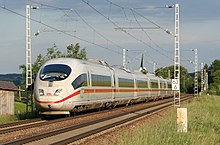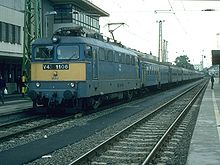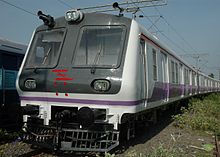| Revision as of 15:03, 20 July 2008 view sourceMion (talk | contribs)Extended confirmed users18,091 edits →See also: +Hydrail← Previous edit | Revision as of 06:54, 21 July 2008 view source COMPFUNK2 (talk | contribs)17,960 editsm tagNext edit → | ||
| Line 1: | Line 1: | ||
| {{sprotect}} | {{sprotect}} | ||
| {{otheruses1|the vehicle}} | |||
| :''For other uses see ] and ]'' | |||
| {{train topics}} | {{train topics}} | ||
Revision as of 06:54, 21 July 2008
| Editing of this article by new or unregistered users is currently disabled. See the protection policy and protection log for more details. If you cannot edit this article and you wish to make a change, you can submit an edit request, discuss changes on the talk page, request unprotection, log in, or create an account. |
| Part of a series on |
| Rail transport |
|---|
 |
|
|
| Infrastructure |
|
|
| Service and rolling stock |
|
| Urban rail transit |
|
|
| Miscellanea |
|
|
A train is a connected series of vehicles that move along a track (permanent way) to transport freight or passengers from one place to another. The track usually consists of two rails, but might also be a monorail or maglev guideway. Propulsion for the train is provided by a separate locomotive, or from individual motors in self-propelled multiple units. Most modern trains are powered by diesel locomotives or by electricity supplied by overhead wires or additional rails, although historically (from the early 19th century to the mid-20th century) the steam locomotive was the dominant form of locomotive power. Other sources of power (such as horses, rope or wire, gravity, pneumatics, and gas turbines) are possible.
The word 'train' comes from the Old French trahiner, itself from the Latin trahere 'pull, draw'.
Types of trains



There are various types of train designed for particular purposes. A train can consist of a combination of one or more locomotives and attached railroad cars, or a self-propelled multiple unit (or occasionally a single powered coach, called a railcar). Trains can also be hauled by horses, pulled by a cable, or run downhill by gravity.
Special kinds of trains running on corresponding special 'railways' are atmospheric railways, monorails, high-speed railways, maglev, rubber-tired underground, funicular and cog railways.
A passenger train may consist of one or several locomotives, and one or more coaches. Alternatively, a train may consist entirely of passenger carrying coaches, some or all of which are powered as a "multiple unit". In many parts of the world, particularly Japan and Europe, high-speed rail is utilized extensively for passenger travel.
Freight trains comprise wagons or trucks rather than carriages, though some parcel and mail trains (especially Travelling Post Offices) are outwardly more like passenger trains.
Trains can also be 'mixed', comprising both passenger accommodation and freight vehicles. Such mixed trains are most likely to occur where services are infrequent, and running separate passenger and freight trains is not cost-effective, though the differing needs of passengers and freight usually means this is avoided where possible.
Special trains are also used for track maintenance; in some places, this is called maintenance of way.
In the United Kingdom, a train hauled by two locomotives is said to be "double-headed", and in Canada and the United States it is quite common for a long freight train to be headed by three or more locomotives. A train with a locomotive attached at each end is described as 'top and tailed', this practice typically being used when there are no reversing facilities available. Where a second locomotive is attached temporarily to assist a train up steep banks or grades (or down them by providing braking power) it is referred to as 'banking' in the UK, or 'helper service' in North America. Recently, many loaded trains in the US have been made up with one or more locomotives in the middle or at the rear of the train, operated remotely from the lead cab. This is referred to as "DP" or "Distributed Power."
Official terminology

The railway terminology that is used to describe a 'train' varies between countries.
- United Kingdom
In the United Kingdom, the interchangeable terms set and unit are used to refer to a group of permanently or semi-permanently coupled vehicles, such as those of a multiple unit. While when referring to a train made up of a variety of vehicles, or of several sets/units, the term formation is used. (Although the UK public and media often forgo 'formation', for simply 'train'.) The word rake is also used for a group of coaches or wagons.
In the United Kingdom Section 83(1) of the Railways Act 1993 defines "train" as follows:
- a) two or more items of rolling stock coupled together, at least one of which is a locomotive; or
- b) a locomotive not coupled to any other rolling stock.
- United States
In the United States, the term consist is used to describe the group of rail vehicles which make up a train. When referring to motive power, consist refers to the group of locomotives powering the train. Similarly, the term trainset refers to a group of rolling stock that is permanently or semi-permanently coupled together to form a unified set of equipment (the term is most often applied to passenger train configurations). Also, in the United States, they sometimes call the engine an 'iron horse', but varies by person as well. The term 'iron horse' was thought of when the steam locomotive first appeared in the United States. They called it that, due to the fact that it replaced the horse on the railway lines, and was made of metal.
The Atchison, Topeka and Santa Fe Railway's 1948 operating rules define a train as: "An engine or more than one engine coupled, with or without cars, displaying markers."
Motive power

The first trains were rope-hauled, gravity powered or pulled by horses, but from the early 19th century almost all were powered by steam locomotives. From the 1920s onwards they began to be replaced by less labour intensive and cleaner (but more complex and expensive) diesel locomotives and electric locomotives, while at about the same time self-propelled multiple unit vehicles of either power system became much more common in passenger service. In most countries dieselisation of locomotives in day-to-day use was completed by the 1970s. A few countries, most notably the People's Republic of China, where coal and labour are cheap, still use steam locomotives, but this is being gradually phased out. Historic steam trains still run in many other countries, for the leisure and enthusiast market.
Electric traction offers a lower cost per mile of train operation but at a higher initial cost, which can only be justified on high traffic lines. Since the cost per mile of construction is much higher, electric traction is less favored on long-distance lines with the exception of long-distance high speed lines. Electric trains receive their current via overhead lines or through a third rail electric system.
Passenger trains
A passenger train is one which includes passenger-carrying vehicles. It may be a self-powered multiple unit or railcar, or else a combination of one or more locomotives and one or more unpowered trailers known as coaches, cars or carriages. Passenger trains travel between stations where passengers may join or leave the train. Many of the more prestigious passenger train services have been given a specific name, some of which have become famous in literature and fiction. India has the largest passenger density in the world.India has one of the largest passenger density due to a great population, referring to a population chart of India, yet it is only one of the most populated countries, but is the only populated one to have the greatest passenger density out of the other countries.
Long-distance trains

Long-distance trains travel between many cities and/or regions of a country, and sometimes cross several countries. They often have a dining car or restaurant car to allow passengers to have a meal during the course of their journey. Trains traveling overnight may also have sleeping cars.
High-speed trains
Main article: High-speed rail
In Japan, most of the public transportation between the Tokyo metropolitan area and the Osaka metropolitan area (around 500 km) is dominated by the Shinkansen, however in longer journeys (such as Tokyo-Hiroshima) more people prefer to travel by air.
Very fast trains sometimes tilt, like the APT, the Pendolino, or the Talgo. Tilting is a system where the passenger cars automatically lean into curves, reducing the sideways g-forces on passengers and permitting higher speeds on curves in the track with greater passenger comfort.
The fastest train on rails is the French TGV (Train à Grande Vitesse) (French for High Speed Train) which achieved a 574.8 km/h (356 mph) speed in testing in 2007. However, TGVs run at a maximum commercial speed of 300-320 km/h. The German ICE uses this commercial speed of 300-320 km/h as well.
Inter-city trains
Trains connecting cities can be distinguished into two groups, inter-city trains, which do not halt at small stations, and trains that serve all stations, usually known as local trains or "stoppers" (and sometimes an intermediate type, usually known as limited-stop).
Branch line trains
Branch lines are usually defined as connections to local stations or local lines and usually stopping services, running to all stations or the majority of stations on a line.
Commuter trains


For shorter distances many cities have networks of commuter trains, serving the city and its suburbs. Some carriages may be laid out to have more standing room than seats, or to facilitate the carrying of prams, cycles or wheelchairs. Some countries have double-decked passenger trains for use in conurbations. Double deck high speed and sleeper trains are becoming more common in mainland Europe.
Passenger trains usually have emergency brake handles (or a "communication cord") that the public can operate. Abuse is punished by a heavy fine.
Large cities often have a metro system, also called underground, subway or tube. The trains are electrically powered, usually by third rail, and their railroads are separate from other traffic, without level crossings. Usually they run in tunnels in the city center and sometimes on elevated structures in the outer parts of the city. They can accelerate and decelerate faster than heavier, long-distance trains.
A light one- or two-car rail vehicle running through the streets is by convention not considered a train but rather a tram, trolley, light-rail vehicle or streetcar, but the distinction is not always strict. In some countries such as the United Kingdom the distinction between a tramway and a railway is precise and defined in law.
The term light rail is sometimes used for a modern tram, but it may also mean an intermediate form between a tram and a train, similar to metro except that it may have level crossings. These are often protected with crossing gates. They may also be called a trolley.
Maglev trains and monorails represent minor technologies in the train field.
The term rapid transit is used for public transport such as commuter trains, metro and light rail. However, in New York City, lines on the New York City Subway have been referred to as "trains".
Some commuter trains in Tokyo, Japan have special cars which the bench seats fold up to provide standing room only during the morning rush hour (until 10 a.m.). The E231 series train has two of these cars in each set (usually as part of a 10- or 11-car set), officially nicknamed "roku-tobira-sha" (literally, "6 door car") - all the other cars have four sets of doors on each side.
An estimated 3.5 million passengers ride every day on Tokyo's Yamanote Line, with its 29 stations. For comparison, the New York City Subway carries 4.8 million passengers per day on 26 lines serving 468 stations.
Named trains
Railway companies often give a name to a train service as a marketing exercise, to raise the profile of the service and hence attract more passengers (and also to gain kudos for the company). Usually, naming is reserved for the most prestigious trains: the high-speed express trains between major cities, stopping at few intermediate stations. The names of services such as the Orient Express, the Flying Scotsman, the Flèche d’Or and the Royal Scot have passed into popular culture.
See also: Famous trains See also: Passenger trainsA somewhat less common practice is the naming of freight trains, for the same commercial reasons. The "Condor" was an overnight London-Glasgow express goods train, in the 1960s, hauled by pairs of "Metrovick" diesel locomotives. In the mid-1960s, British Rail introduced the "Freightliner" brand, for the new train services carrying containers between dedicated terminals around the rail network. The Rev. W. Awdry also named freight trains, coining the term The Flying Kipper for the overnight express fish train that appeared in his stories in The Railway Series books.
Freight trains


A freight train (also known as goods train) uses freight cars (also known as wagons or trucks) to transport goods or materials (cargo) – essentially any train that is not used for carrying passengers. Much of the world's freight is transported by train, and in the USA the rail system is used more for transporting freight than passengers.
Under the right circumstances, transporting freight by train is highly economic, and also more energy efficient than transporting freight by road. Rail freight is most economic when freight is being carried in bulk and over long distances, but is less suited to short distances and small loads. Bulk aggregate movements of a mere twenty miles (32 km) can be cost effective even allowing for trans-shipment costs. These trans-shipment costs dominate in many cases and many modern practices such as container freight are aimed at minimizing these.
The main disadvantage of rail freight is its lack of flexibility. For this reason, rail has lost much of the freight business to road competition. Many governments are now trying to encourage more freight onto trains, because of the benefits that it would bring.
There are many different types of freight trains, which are used to carry many different kinds of freight, with many different types of wagons. One of the most common types on modern railways are container trains, where containers can be lifted on and off the train by cranes and loaded off or onto trucks or ships.
This type of freight train has largely superseded the traditional boxcar (wagon-load) type of freight train, with which the cargo has to be loaded or unloaded manually.
In some countries "piggy-back" trains are used: trucks can drive straight onto the train and drive off again when the end destination is reached. A system like this is used through the Channel Tunnel between England and France, and for the trans-Alpine service between France and Italy (this service uses Modalohr road trailer carriers). 'Piggy-back' trains are the fastest growing type of freight trains in the United States, where they are also known as 'trailer on flatcar' or TOFC trains. 'Piggy-back' trains require no special modifications to the vehicles being carried. An alternative type of "inter-modal" vehicle, known as a Roadrailer, is designed to be physically attached to the train. The original trailers were fitted with two sets of wheels: one set flanged, for the trailer to run connected to other such trailers as a rail vehicle in a train; and one set tyred, for use as the semi-trailer of a road vehicle. More modern trailers have only road wheels and are designed to be carried on specially adapted bogies (trucks) when moving on rails.
There are also many other types of wagons, such as "low loader" wagons for transporting road vehicles. There are refrigerator cars for transporting foods such as ice cream. There are simple types of open-topped wagons for transporting minerals and bulk material such as coal, and tankers for transporting liquids and gases. Today however most coal and aggregates are moved in hopper wagons that can be filled and discharged rapidly, to enable efficient handling of the materials.
Freight trains are sometimes illegally boarded by passengers who do not wish to pay money, or do not have the money to travel by ordinary means. This is referred to as "hopping" and is considered by some communities to be a viable form of transport. Most hoppers sneak into train yards and stow away in boxcars. More bold hoppers will catch a train "on the fly", that is, as it is moving, leading to occasional fatalities.
Gallery
-
 Airport Express train in Oslo, Norway
Airport Express train in Oslo, Norway
-
 An electric Transperth train at Mclver, Perth, Western Australia
An electric Transperth train at Mclver, Perth, Western Australia
-
 A heritage steam train in Poland
A heritage steam train in Poland
-
 An early horse-pulled train
An early horse-pulled train
See also
- Armoured train
- Famous trains
- Heaviest trains
- History of rail transport
- Hydrail
- List of rail accidents
- List of railway companies
- Monorail
- Rail transport modelling
- Rail transport in fiction
- Toy train
- Unit train
References
- "Train (noun)". (definition - Compact OED). Oxford University Press. Retrieved 2008-03-18.
- Atchison, Topeka and Santa Fe Railway (1948). Rules: Operating Department. pp. p 7.
{{cite book}}:|pages=has extra text (help); Cite has empty unknown parameter:|1=(help) - The South Asian: Education trends in India: a look at the statistics
- Central Japan Railway (2006). Central Japan Railway Data Book 2006. pp. p 16.
{{cite book}}:|pages=has extra text (help); Cite has empty unknown parameter:|1=(help)
Further reading
- Glancey, Jonathan (2005), The Train, Carlton Publishing Group, ISBN 978-1-844423-45-3, 256 pp.